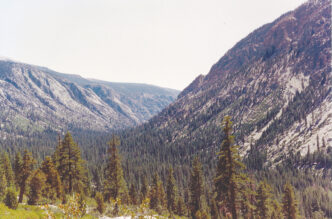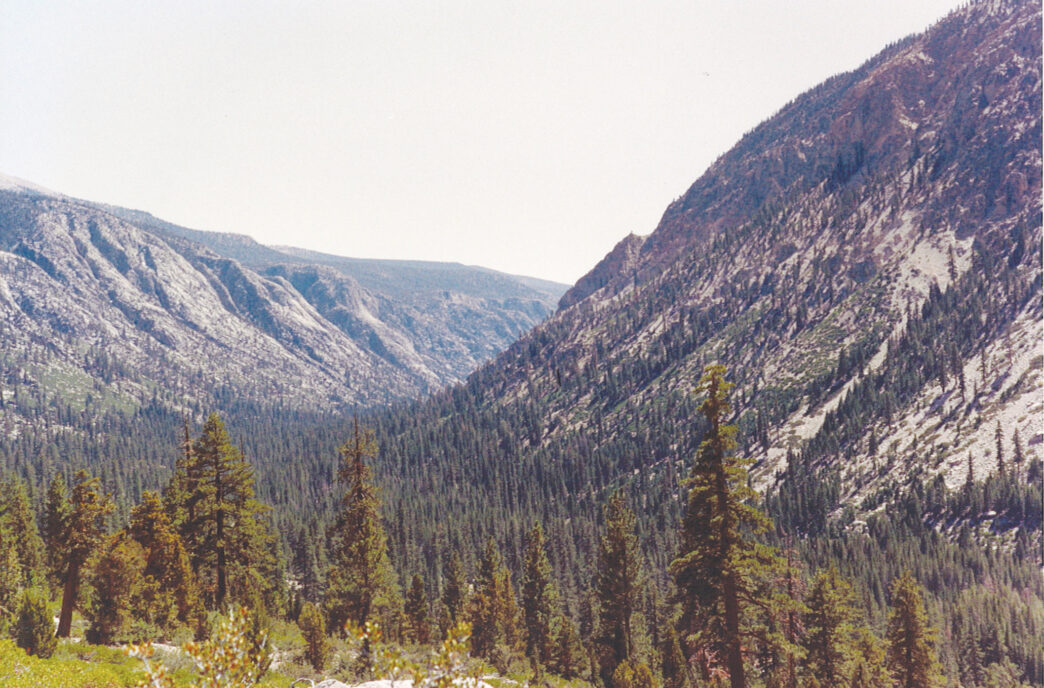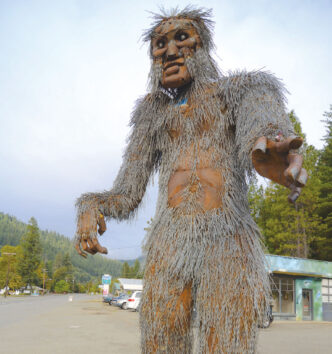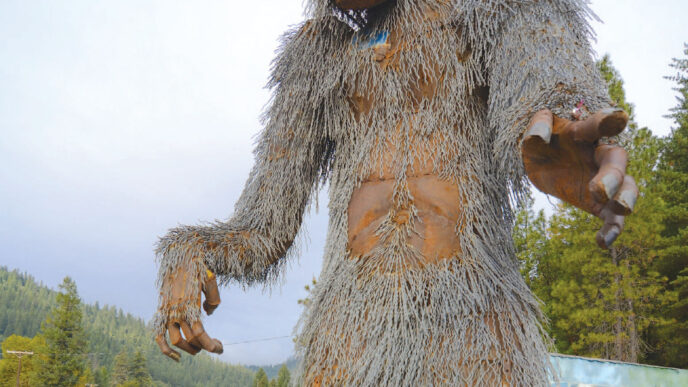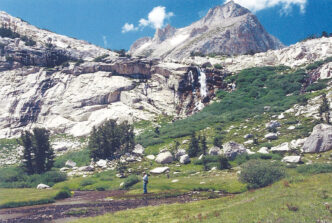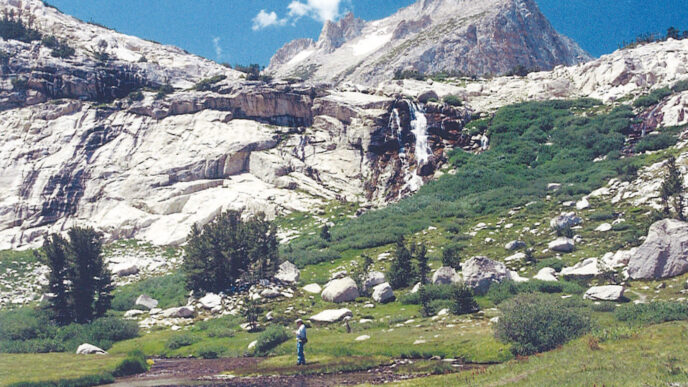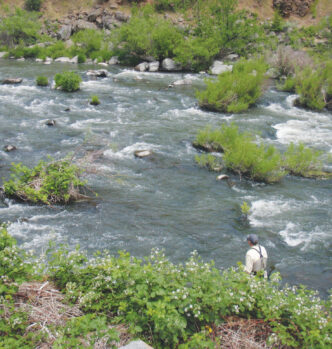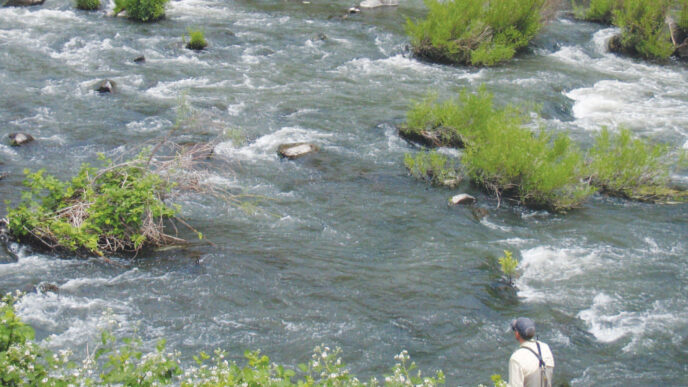Over the years, I have gone from being an occasional visitor to the Sierra backcountry, armed with Genny Smith’s wonderful 1976 guidebook Mammoth Lakes Sierra: A Handbook for Road and Trail, to someone who has crossed the Sierra crest at every opportunity, and finally to being a full-time resident with a view out my window of 30 miles or so of Sierra massif. Sadly, living here does not guarantee you will fish constantly. Life pulls and tugs in unexpected ways.
This is the place where, during a long and frustrating summer, I “taught” myself to cast a fly rod. Fortunately, I then met a guide in Mammoth who was able to undo the results and get me on track. He became a close friend, and we have fished some incredible waters for amazing trout. I worked my way through countless stores, catalogs, and Web sites in search of the perfect combination of gear, which I now purge, trying to simplify my life. I like to think I figured out some stuff that has led me a little closer to understanding what I am trying to do with this fishing and why, but 20 years on, it still remains mysterious and magical.
The fly-fishing experience is one of establishing a connection between the angler and the trout. This is more than hooking up. It involves a relationship between me and the place where the fish reside. The experience is made up of the water and its features, the insects and vegetation that support the trout, birds, animals and their tracks, wildflowers, the watershed, the highest peaks, and the drama of afternoon weather. I need a measure of solitude to take all that in. My basic strategy is to get into the country and away from the pavement and the throngs.
Here on the east side, we play host to hundreds of thousands of visitors every year who come to experience the magic. Many of these people are fly fishers. Often, their vision of what is possible is limited to the usual suspects: Hot Creek, the Owens River, the Walker River, waters along the roadways such as Bishop, Rock, Big Pine, or Convict Creeks, or the lakes — Convict, Crowley, the Mammoth Lakes Basin, the Twin Lakes, or Bridgeport Reservoir. There are good reasons why these destinations are so popular and so often crowded, but there is more. So let me extend an invitation to the reader to check out the opportunities found in our high places — a do-it-yourself guide to Sierra high-country angling.
The less-visited places can be accessed by day trips/hikes, one-night or two-night pack trips, or the grand experience of a trip that’s a week or more in length. No matter what your time frame, the initial question is where to go. I am motivated by curiosity. The inspiration for many of my trips came from photographs on Yosemite Valley and Galen Rowell’s Mountain Light Gallery in Bishop. I see an image — for example, of Pioneer Basin, Evolution Valley, or Dusy Basin — and say to my wife, “We need to go there.” Or I may be hiking and stop and look across a high basin at what appears to be a stream drainage and just need to know what sort of angling it offers. There are places I have seen while travelling and asked, “I wonder what it’s like to fish that spot.” Here’s how to find the answers.
Resources for Explorers
A good place to begin is at a local fly shop. It can take a bit of time to convince people you are serious about wanting to find an out-of-the way spot and really do not care if you don’t catch giant fish, but almost every shop employee has a trick up his or her sleeve. Don’t overlook the hiking/backpacking stores, either. Their employees know a lot about trails and where they go. Some of the staff may fish, and even if they don’t, they hike so much that they can tell you where they have seen fish or people fishing.
If you can’t find any good or new tips, it is time to do additional research. The most direct way is to look around as you are driving through the country. My eye is always looking for that little stream way down below the road or a creek that emerges from a high basin. Every time I cross a stream, I wonder where it comes from, where does goes, and how one could get there. If you have time and there is access, you can pull over and start walking. Not many people actually leave sight of their car and fewer still walk more than a half hour. Every step takes you away from water that has experienced angling pressure.
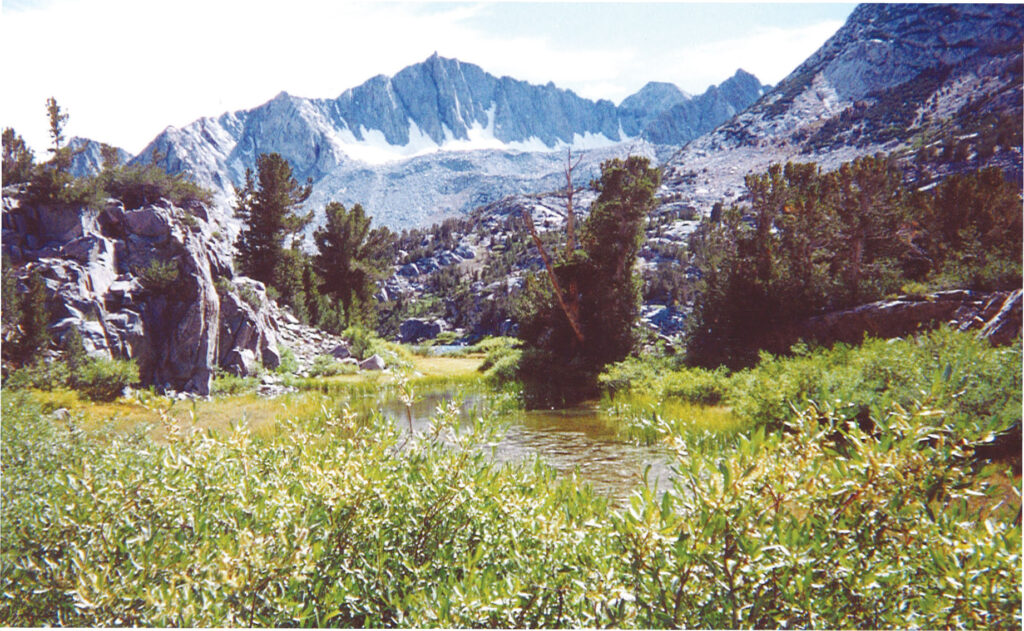
If I can’t jump out and explore, I check things out on a map when I get home, looking for access and places where the stream is a significant distance from the road. This all gets filed somewhere in my head, and years may pass between that first glimpse of a possibility and the actual exploration. No matter. By and large, the creek isn’t going anywhere.
Often, I have discovered day trips while doing a longer trip. One year, my wife and I made a seven-day trip over McGee Pass and then later came back and spent a day fishing along the inviting waters we had to pass up on the first day of the long trip. We’ve done the same on Piute Pass, Bishop Pass, the trail to Thousand Island Lake, out of Cottonwood Pass, and in other locales.
Since I know I am looking to walk to the fish, Sierra maps and hiking and backpacking guides are a vital part of my fishing equipment. There are hiking guides to Sierra fishing, and they can be valuable, for example, Charles S. Beck and Steve Beck’s Trout Fishing the John Muir Trail (Frank Amato Publications, 2000; $19.95) and Charles S. Beck’s Yosemite Trout Fishing Guide (Frank Amato Publications, 2002; $19.95). But for me, the best information for planning a fishing trip is found in guides written for hikers, rather than anglers. These have a lot more detail about what you can expect on the trail and the kind of country you are going to encounter. I regularly use Sierra North: Backcountry Trips in California’s Sierra Nevada, by Kate Morey, Mike White, Stacey Cor-less, and Thomas Winnett ( Wilderness Press, 2005; $18.95) and Sierra South: Backcountry Trips in California’s Sierra Nevada, by Kate Morey, Mike White, Stacey Corless, Analise Elliot, Chris Terrell, and Thomas Winnett ( Wilderness Press, 2006; $18.95), Starr’s Guide to the John Muir Trail, by Walter A. Starr, Jr. (Sierra Club, 1967; available used), and The High Sierra: Peaks, Passes, and Trails, by R. J. Secor (Mountaineers Books, 1999; available used). The maps I use most and carry are waterproof topographical maps from Tom Harrison, http://www.tomharrisonmaps.com.
Many Options for Hikes
Influenced no doubt by the organization of these hiking books, I tend to think of the Sierra landscape in terms of watersheds and trailheads. From Levitt Meadows in the north to Horseshoe Meadows south of Lone Pine, there are more than 30 major trailheads accessible from Highway 395. Each one of these presents more than one trip option for time frames from several hours to a full day or overnight excursions of up to ten days or more, and each offers access to more angling treasures than you can count. Every trailhead is the portal to prime fishing in the Sierra. The only question is how much time and effort will be required to get to that fishing. Use a hiking guide to learn if you can get to fish in a matter of hours or a full day or whether it will require an overnight or even multiday trip.
As I said, day trips can be found in longer trips, and you don’t have to be on foot to find them. They’re right there in the backpacking guides. Look for a trip that follows a stream course or connects with one a couple of miles from the trailhead. The vast majority of hikers do not fish, and the majority of those who do march along the trail until they reach the destination of the hike, usually a lake. Any water with fish between the trailhead and the destination is often overlooked. You probably will have to drop off the trail to reach this water and frequently will have to fight your way through obstacles such as willows, deadfalls, or bogs. These challenges are the reason why you should go with another person. Bad things can happen off the trail, even within half a mile from the parking lot.
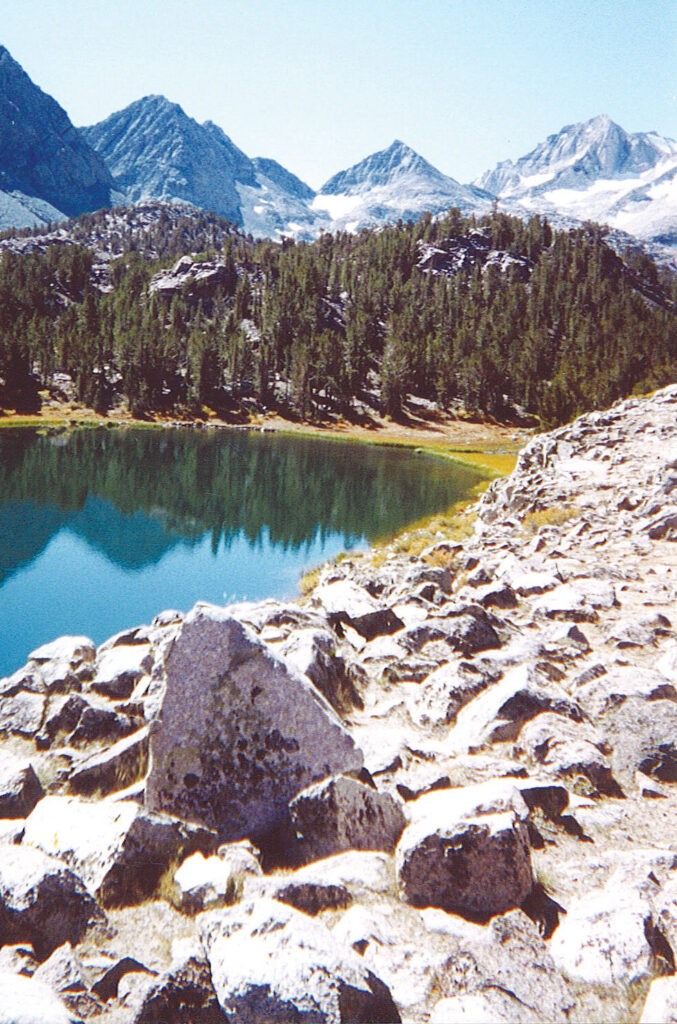
When planning your day hike, think about what you are looking for: a specific kind of fish, a certain kind or size of water, meadow fishing, easy access, the amount of time spent in the approach hike, forest cover, drop-dead scenery, or any of a dozen other variables. Look for a trip that matches your level of ambition. For a short day, I exclude the trailheads that start off with a long, strenuous uphill grind. I generally want to fish, rather than walk, and I do not want to leave a place feeling that I did not have time to explore its possibilities. There are so many places to walk to in a day, there is no way to compile a list, but I know that every year will find me in Little Lakes Valley, up high on the West Walker, working the headwaters of Bishop Creek, down on the Middle Fork of the San Joaquin, or fiddling around somewhere in the Horseshoe Meadows area.
If you have a couple of days to commit to a destination, there are a great many opportunities to spend one or two nights in the backcountry. If you haven’t gone backpacking in a while or at all, there are ways to give it a try without a lot of personal or financial risk. If you do not have equipment, it can be rented. Get some help picking out what you need to sleep, cook, and keep out of the weather. Look for what’s light and simple. If you don’t have experience, stores such as REI offer seminars, and organizations such as The Yosemite Conservancy offer organized trips. Again, a store such as REI usually has information about these trips. Don’t worry if a trip is not put together by a fishing group. On my wife’s first long trip, she was the only person who fished and had the headwaters of Mono Creek and Fish Creek all to herself during a 10-day hike.
If you are planning your own trip, gather information the same way as with day hikes. After getting some preliminary ideas, refer to a hiking guidebook or the U.S. Forest Service office to get details. This will give you an idea of distance, altitude changes, time frames, camping locations, and potential issues with regulations. Use this information to find a trip that matches the experience, fitness, and expectations of your group. You will find that the descriptions of many backpacking trips in guidebooks end with a specific destination, which is often a lake. These destinations can get crowded because lots of people are using the same book. Because you will be fishing, think about stopping somewhere along the stream that drains or connects the destination lakes.
Consider your degree of tolerance for other campers. Easier destinations are obviously more popular. Remember, most hikers do not fish, so even though there may be a lot of people around, if you pick a spot to camp away from the destination designated in the guidebook, you stand a good chance of having some space. Check with the Forest Service to learn which trailheads are less heavily used and ask why. Sometimes it is because they are difficult to hike, but it could also be that they just are not as famous.
My favorite short-trip trailheads include Mosquito Flats (Little Lakes Valley, pretty flat walking, but crowded with day hikers and campers), any of the trailheads in Tuolumne Meadows (Lyell Fork, Dana Fork, the Cathedral Lakes area, and the Tuolumne River downstream), Saddlebag Lake, Agnew Meadows upstream along the San Joaquin or up toward Clark Lakes, and the Horseshoe Meadows–Cottonwood areas. Besides these familiar spots, there is a long list of places I want to see.
Overnight trips are subject to a variety of regulations. Most destinations are likely to be inside designated wilderness areas, so a wilderness permit is needed. These permits are issued by the U.S. Forest Service for national forest destinations or by Yosemite or Kings Canyon National Parks. You can apply in advance for a permit using the Internet, or you can take your chances of obtaining one by stopping at a Forest Service office the day before or day of the start of your trip. There are quotas on the number of permits that are issued for specific geographic areas. These limitations are attached to the point of entry. This can get complicated, so the best idea for a planned trip is to reserve a permit. If seeking a permit on the spur of the moment, be prepared with some alternative destination plans. Information on these permits can be obtained from the U.S. Forest Service Web site for the specific forest or the sites for the two national parks. Regulations also apply to the carrying and storage of food in order to avoid bear incidents, restrictions on campfires, and areas that are off-limits to overnight camping.
There is nothing like total immersion, though — the multiday trip deep into the backcountry. If you have not spent a week or so in the Sierra wilderness, you will be blown away by the experience. I have seen places that were so perfect I still am amazed at what was there. The drama of the Sierra crest and Sierra skies can be savored only by spending time above the timberline or in one of the high meadows. It is also wonderful to have a block of time during which there is not much else to do but fish in a place where there are a lot of trout. My fly fishing life was saved by one of these trips. I had spent more than a week thrashing the water with my deplorable skills. Fortunately, the wild trout were not completely contemptuous of my efforts. My wife and I hiked over McGee Pass and set up a base camp near the headwaters of Fish Creek. The original plan was to lake hop in the various basins, probably with spinning rods, but that all changed with the first look at the creek. The picture-perfect stream ran through a beautiful landscape of meadows and cascades, and my resolve to fish only with a fly rod was renewed. For four days, we explored the creek, pushing farther downstream from our camp. The trouble was, the fishing was so good, you could spend a day on just a mile or so of twisting meadow stream or fast pocket water. At the end of the last day, I looked at the place where the creek wound out of sight and knew I had to come back and would always bring nothing but what had been the dreaded fly rod. These 20 years have seen five return trips along almost the full length of Fish Creek, and I would go again tomorrow.
Planning for multiday trips basically revolves around factors of time, distance, and altitude gain. All trails in the eastern Sierra require an initial uphill grade, which can range from the sublime (Mosquito Pass Trailhead) to the ridiculous (Shepherd Pass). In the trail guides, look for solid information about how the trail contours, total altitude gain, distances to destinations, and camping conditions once you are there. Also be alert for really vital details such as water availability or that, say, the trail out of Onion Valley can be really hot in the morning. When you look at the suggested time frames for the trips, give yourself plenty of extra time, too. You are not going on a death march — you are headed out to fish.
Ideas for Destinations
There are dozens of worthwhile multiday destinations, but my favorites from the past twenty years include Fish Creek, the north boundary country of Yosemite, the upper Kern River and Kern Canyon, and the Golden Trout Wilderness.
Fish Creek is a popular backcountry destination; you will certainly see other people, but there are no crowds. As a packer once told me, there is a reason it is called Fish Creek. The water has every kind of structure you could imagine. The fish are rainbow-golden hybrids, and every one of them is beautiful. The creek can be accessed from several trailheads: Duck Pass, McGee Pass, Reds Meadows (both the Muir or Fish Creek Trails), or for the truly adventurous, Mono Pass.
The north boundary country of Yosemite does not suffer from big crowds of people, and it can provide the setting for trips of up to 10 days or shorter 2-day or 3-day visits. The first couple of days bring you to Glen Aulin and the glory of the Tuolumne River and its falls and cascades. It is not easy to get a campsite at Glen Aulin (the Glen Aulin High Camp requires advance planning and reservations and is pricey), but you can possibly find a place near the river at another location. Farther in, you can access the McCabe Lakes Basin or drop down to Return Creek, which flows through striking rock features and contains lots of brookies that love dry flies. Another day in brings you to Matterhorn Creek with another population of brightly marked brook trout. Keep going to Smedberg Lake, with its strangely aquamarine-colored rainbow trout, and Benson Lake’s broad sand beach, dramatic rockbound setting, and large fish. From Benson, you can backtrack either to Tuolumne Meadows or to connections that could take you to Hetch Hetchy or continue forward to catch a lateral that will drop you out near Bridgeport. The full Tuolumne-to-Bridgeport loop is an outstanding 10-day to two-week trip that can meet your backcountry fishing expectations in a very quiet section of Yosemite.
The upper Kern River and the Kern Canyon are a lifetime trip for me: big river; big, wild fish, and a canyon that rivals Yosemite Valley for dramatic splendor without a hint of the tourist hordes. This is a long and difficult trip, but there are rewards at every turn. My wife and I went in from Horseshoe Meadows and took two days to get to the Kern by way of the South Fork of the Kern and Volcano Creek. These streams are the highlight of a trip to the Golden Trout Wilderness and are the historic home to California’s state fish. We had a couple of hours at Volcano Creek on the layover night going to the Kern, and it was not nearly enough. The only way to deal with that was to come back when I could hang out for a few days. The Kern River is large by Sierra standards, and it holds some big, healthy rainbows. The river runs through miles of pockets at the base of a canyon that is more than a mile deep and perhaps no more than half a mile wide. Although it is evocative of Yosemite, it is far more narrow and confining. I would guess that the trout would respond to subsurface patterns, but I never have had to find out. We had a field day with grasshopper patterns, pretty much casting until we dropped. We spent three days in the canyon, working all the way up to the trail to Wallace lake in one move. I wanted to take a lot more time on that stretch and then go all the way up to Milestone Basin, if for no other reason than to see it.
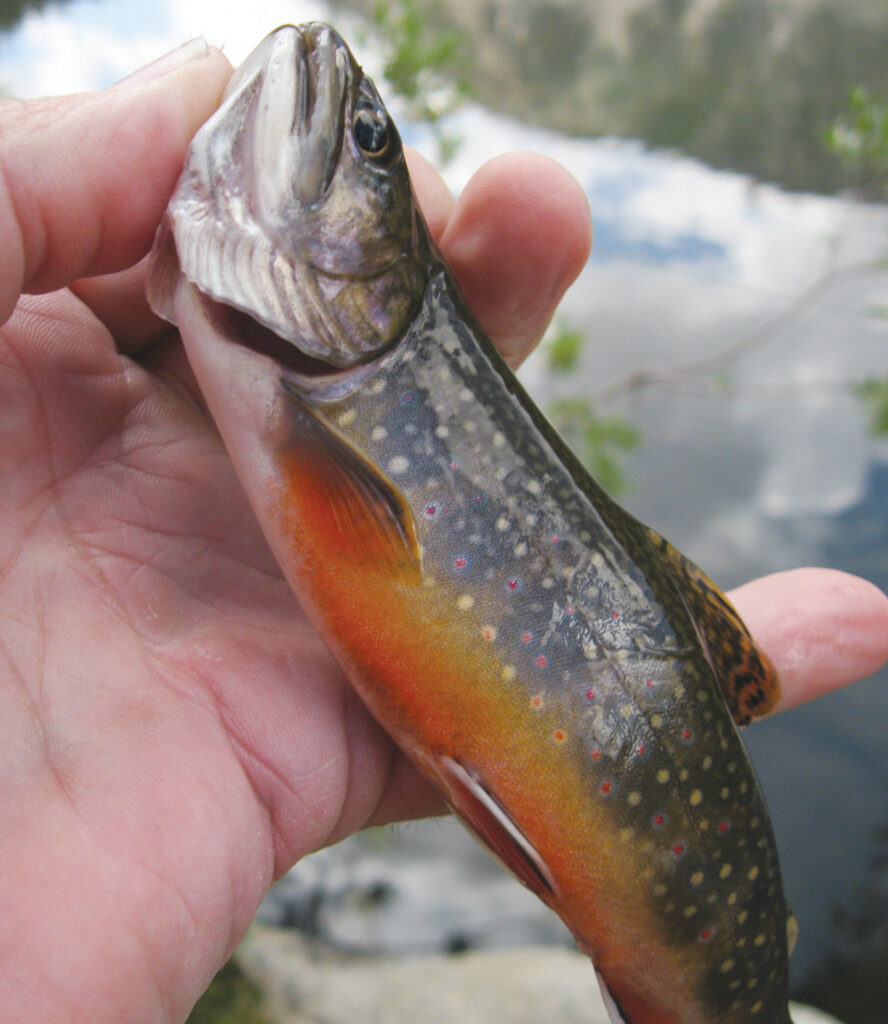
We finished up by visiting Wallace Lake, Crabtree Lakes, and Rock Creek on the way to a return to the Horseshoe Meadow parking area. These latter places are among my favorites and make outstanding trip destinations on their own. The Kern can be accessed from a lot of different directions, but every one of them demands a long walk-in, and the shorter routes bring some serious elevation changes. The name of the Golden Trout Wilderness says it all. It is the ancestral home of the Kern River golden trout and the Volcano Creek golden. It is a place rich in interesting history, and the surrounding country is unlike any other in the Sierra. The fish are found in the South Fork of the Kern and Volcano Creek, both of which wind through large meadows until they begin to pick up speed and descend toward the main body of the Kern River. The trout strains have been mixed, so almost all the fish have been hybridized. (A search has been made to try to locate pure specimens of either or both species.) Both creeks are brushy and small. The fish are eager to respond to dry flies, and there are enough surprisingly large fish, up to a foot long, to keep things interesting. The biggest reward is that every single one of these creatures is a jewel to look at. It is pretty amazing that any fish could be so striking. A final nice feature of the Golden Trout Wilderness is that it is gentle country that does not require the usual uphill grind. The Horseshoe Meadows Trailhead access is located south of the town of Lone Pine.
By the way, if you find the idea of a long-distance backpacking trip a physical impossibility, all of these destinations and more can also be reached by using commercial pack operators. I know there is controversy here, but I have treasured memories of trips taken with my closest fishing partners that could not have been made by hiking due to their medical issues. I am now reaching that stage of my own life and do not want to forfeit the wonders of the backcountry. Packers are highly regulated and understand that if the appeal of the landscape in which they operate is diminished, they are out of business. If you shop around and look for recommendations, you can be pretty confident that you will have an entirely satisfactory experience, whether you opt for a fullservice trip in which your meals are prepared by a backcountry cook and your camps are established and maintained by staff or just make use of mule power to haul in your equipment to establish a central base camp.
Equipment for the High Sierra
I have spent a lot of time, imagination, and a fair amount of money chasing the perfect mix of equipment. At this point, although I still look at gear, I find less and less that interests me. “Simplification” has become my watchword. I want gear that will take up less room in the house and that packs down to a small bundle that I can grab and throw into somebody’s car. I have six fly rods, but I’ve used only one so far this year. It is a five-piece 8-1/2-foot 4-weight. It is packable — a necessity, because I try to walk at least an hour to most places I fish. It is on the stiff side in terms of action —not to cast a mile, but to deal with the wind. Afternoons are windy in the eastern Sierra. We are not
talking breezes here, but the kind of wind that will blow you and your float tube clear across Crowley. I need all the help I can get when casting, and so I prefer a rod with backbone. I own a 5-weight rod, but haven’t fished it in several years. Sometimes, on really intimate waters, I take an 8-1/2 foot 3-weight and fish with it exclusively for about a month. I have spent the last year or so contemplating buying a 7-foot or 7-1/2-foot stick, given my fascination with small creeks.
My equipment is tailored to the places I fish. Although my go-to rod is a bit long, everything else is designed not to require a vest or anything that can get caught in willows or other shrubbery. Leaders are no more than 7-1/2 feet long unless I am heading for Hot Creek or the Owens. The tippet is usually 6X, seldom heavier than 5X. For the rest of my gear, I have a neck lanyard with nippers, forceps, tippet, and floatant. Somewhere I find a place for a spare leader, some corkies, and a film container of shot.
That’s it for me. Except, of course for the flies. My quest for simplification has failed me in this department. I am my own worst enemy, because I spend more and more time tying anything that looks interesting in a store or magazine or “improving” already successful patterns with my own tinkering. So all these flies come into being, and something has to be done with them. A year ago, I carried one small floating box. I have since added a large box, and I worry that this is not enough. Thank goodness they are light. On the days when I go to the more popular spots, I have to remind myself to add flies, though, or I find myself without enough options when dealing with truly picky fish.
The most important part of the equipment list covers the things that you need when you are any significant distance from your car or from help. I spend a lot of time reading search-and-rescue reports. I am neither skilled nor fit enough to be one of those guys, just curious. I am impressed by how little it takes to create a situation that gets out of hand. Expect weather changes, and bring appropriate layers of clothing. I pack a basic first-aid kit, along with a signal mirror, a whistle, cord, a knife, and fire-making supplies. And know where you are. This means more than just bringing a map, but orienting yourself to the area before you start out and anytime you make a cross-country journey off the trail. Throw all this gear in a day pack, along with some food and water, and you are ready to start the first of what can be your own decades-long relationship with the high Sierra.



